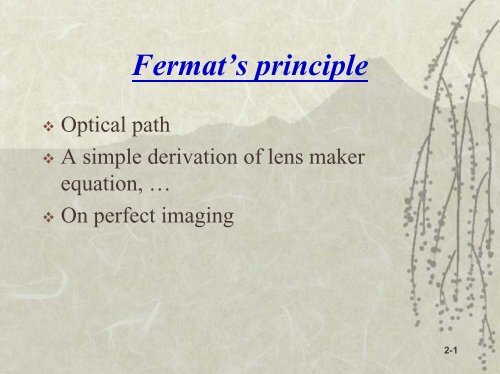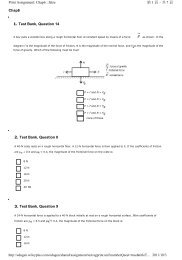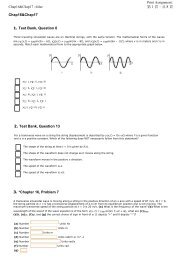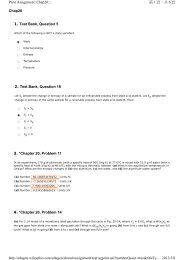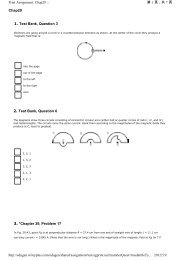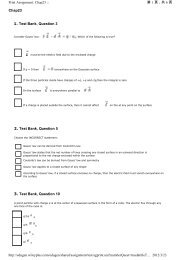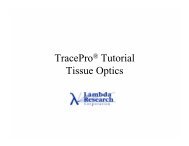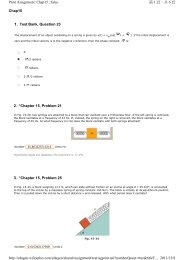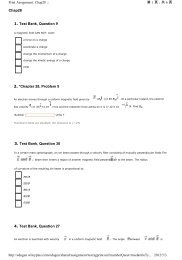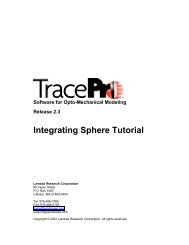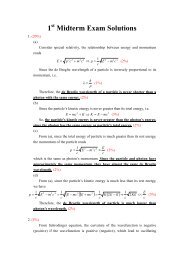Geometrical optics: Fermat's principle
Geometrical optics: Fermat's principle
Geometrical optics: Fermat's principle
You also want an ePaper? Increase the reach of your titles
YUMPU automatically turns print PDFs into web optimized ePapers that Google loves.
Fermat’s <strong>principle</strong> Optical path A simple derivation of lens makerequation, … On perfect imaging2-1
<strong>Geometrical</strong> Optics: Fermat’s <strong>principle</strong>Light travels from a point P to a point P’Time t(P,P’)t(P,P')=P'∫Pdsc/ n=1cP'∫Pndsds: the length of the line elements along the rayIntegral: optical pathfrom P to P’PP'A real optical path should not change even there is a virtualdisplacement, this means that the optical path is stationary asthe virtual variation occurred.2-2
Example 1: refraction by a curved surfaceAPP’x s hx’pqrs=r−r2− h2x, h, x’ are smallr, p, q are largeOptical path(a small-angle approximation)PP'=E(h)=n( p+s)2+ ( h −x)2+n'( q−s)2+ ( h −x')2If we slightly change h, then E(h) should be no change such thatthe optical path is a true trace of light ray2-3
2-4rhhrrs22221~−−=perturbation22222~')()(')()()('ChBhAxhsqnxhspnhEPP++−+−+−++==A=np+n’q+(nx2)/2p+(n’x’2)/2qB=-nx/p-n’x’/qC=[n/p+n’/q-(n’-n)/r]/2hChBChBhAhhEδδ )2()(2++++→+Stationaryvirtual displacement(B+2Ch)=0rnnhpxhnqhxn−−−='− ''
angle AφanglePφ’ P’x s hx’pqrn'x'− h h − x n'−n= n − hq p rOn-axis image:lens makers equationn'+qnp=n'−nrn'φ'=n'−nnφ− hrThis is also the paraxial imagingof properties of a general lenssystem2-5
Example 2: Cartesian surfaces (a surface that yields perfectimaging between a single pair of points)APpP’CqhrsP’ is the perfect image of P:all rays connecting P and P’have the same optical path2 22PP ' = E(h)= n ( p + s)+ h + n'( q − s)+h2So, by the ray passed h=0, we obtained the value of optical pathand then, we have the equation for perfect imaging:n( p+s)2+h2+n'( q− s)2+h2=np+n'qThis provides us the shape equation of lens.2-6
If np+n’q=0, we haven( p2 22+ s)+ h + n'( q − s)+ h2=0h2+ np2 s +n + n's2=0A circle!!After rotation, a sphere with radius: np/(n+n’)A spherical object surface that is imaged perfectlyinto a spherical image surface.2-7
Problem 2-1 Show that the Cartesian surface for anobject at infinity is of the second degree. Due March 12, 20022-8
Problem 2-2 Show that a Cartesian mirror is always ofthe second degree. When does the mirrordegenerate into a plane mirror, and wheninto a sphere. Due March 12, 20022-9


